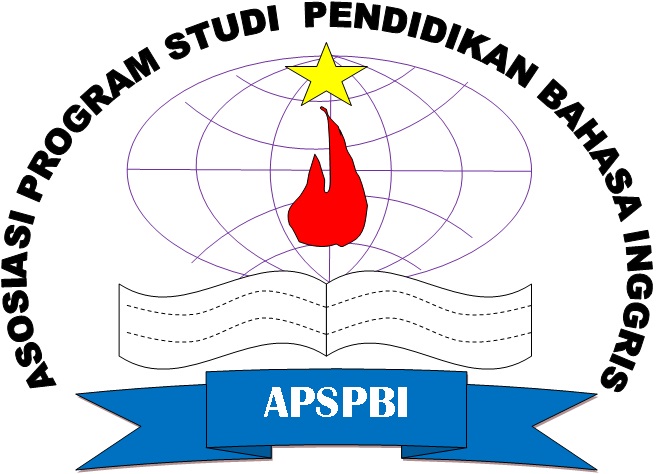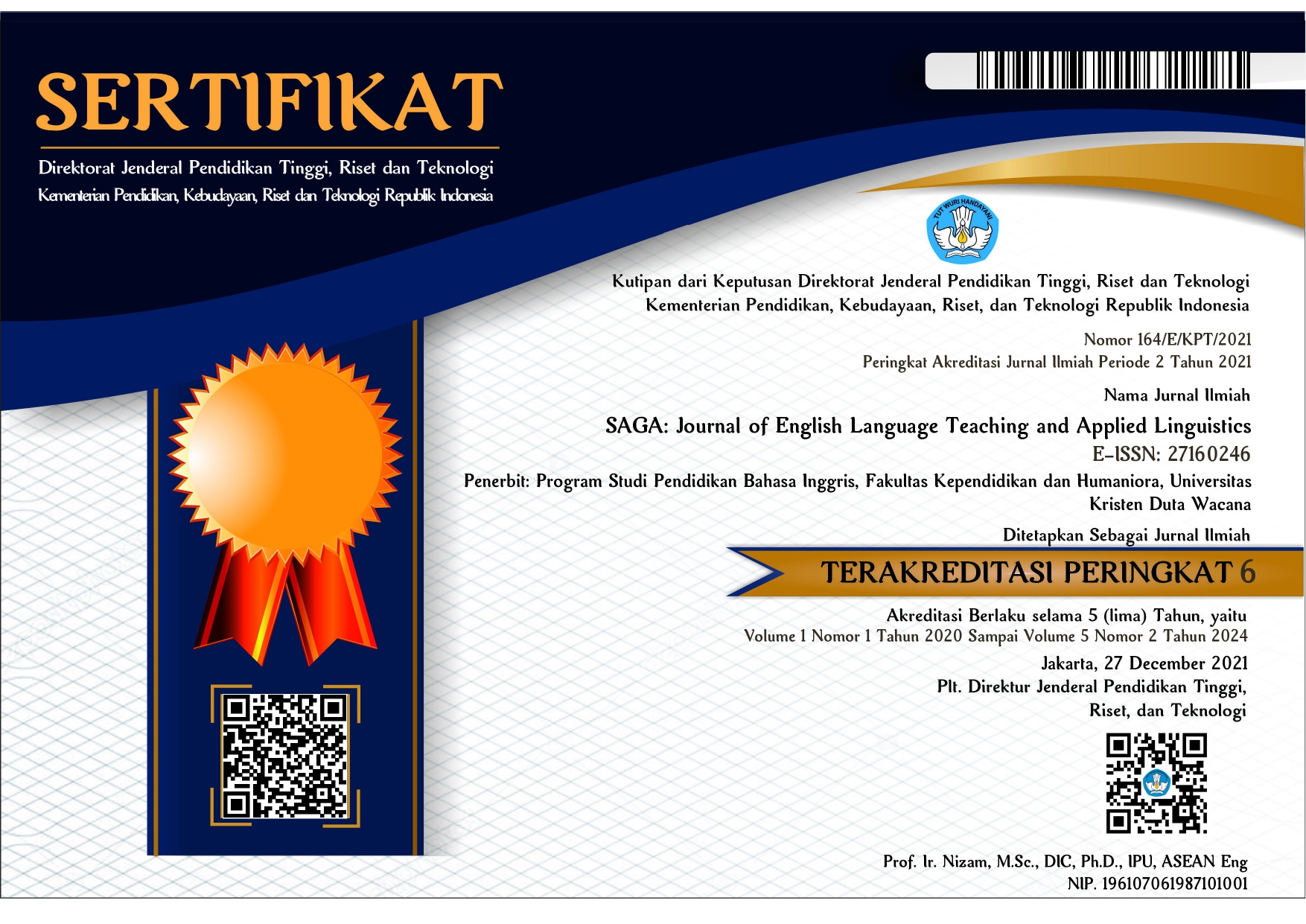O’SPEAK FOR ENGLISH PHONETIC AND PHONOLOGY CLASS: WHAT’S ON STUDENTS’ MIND?
DOI:
https://doi.org/10.21460/saga.2021.22.76Keywords:
hybrid learning; artificial intelligence, speaking; mobile applicationAbstract
In the era of Education 5.0, mobile applications for the teaching-learning process are proliferating. The mobile application also exists in English Phonetics and Phonology Classes. Its name is O’Speak. The use of O’Speak in English Phonetic and Phonology Class derives from the idea of technological development in this digital era. Virtues and hurdles of using O’Speak come out in students’ viewpoints. Therefore, this study is conducted to know the students’ perceptions toward the use of O’Speak in English Phonetic and Phonology Classes. The research method used in this study is a case study that focuses on the phenomenon of O’Speak. English Phonetics and Phonology students are the participants in this study. The finding shows that the students have several overviews toward O’Speak, such as students' concept of O’Speak, O’Speak designs, and O’Speak comments.
References
Albino, G. (2017). Improving Speaking Fluency in a Task-Based Language Teaching Approach: The Case of EFL Learners at PUNIV-Cazenga. SAGE Open, 7(2), 1–11. https://doi.org/10.1177/2158244017691077
Aldahdouh, A. A., Osório, A. J., & Caires, S. (2015). Understanding knowledge network, learning and connectivism. International Journal of Instructional Technology and Distance Learning, 12(10), 3–21. https://papers.ssrn.com/sol3/papers.cfm?abstract_id=3063495%0Ahttp://www.itdl.org/Journal/Oct_15/Oct15.pdf#page=7
Aldahdouh, T. Z., Nokelainen, P., & Korhonen, V. (2020). Technology and Social Media Usage in Higher Education: The Influence of Individual Innovativeness. SAGE Open, 10(1), 1–20. https://doi.org/10.1177/215824401989944
Bøhn, H. (2015). Assessing Spoken EFL Without a Common Rating Scale: Norwegian EFL Teachers’ Conceptions of Construct. SAGE Open, 5(4), 1–12. https://doi.org/10.1177/2158244015621956
Burns, A. (2019). Concepts for Teaching Speaking in the English Language Classroom1. LEARN Journal: Language Education and Acquisition Research Network, 12(1), 1–11.
Cipta, H., Indonesia, M., Hasugian, A. H., & Indonesia, M. (2016). Perancangan Perangkat Lunak Pembelajaran Bermain Gitar. October, 243–250.
Cong-Lem, N. (2018). Web-Based Language Learning (WBLL) for Enhancing L2 Speaking Performance: A Review. Advances in Language and Literary Studies, 9(4), 143–152. https://doi.org/10.7575/aiac.alls.v.9n.4p.143
Curwood, J.S. (2014). English Teachers' Cultural Models about Technology: A Microethnographic Perspective on Professional Development. Journal of Literacy Research, 46 (1), 9-38.
Fabre-Merchan, P., Torres-Jara, G., Andrade-Dominguez, F., Ortiz-Zurita, M. J., & Alvarez-Munoz, P. (2017). A Phenomenological Study: The Impacts of Developing Phonetic Awareness through Technological Resources on English Language Learners’ (ELL) Communicative Competences. English Language Teaching, 10(12), 83–87. https://doi.org/10.5539/elt.v10n12p83
Gall, M. D., Gall, J. P., & Borg, W. R. (2003). Educational research: An introduction (7th ed.). In Boston, MA: A & B Publications.
Hamad, M. M., Metwally, A. A., & Alfaruque, S. Y. (2019). The Impact of Using YouTubes and Audio Tracks Imitation YATI on Improving Speaking Skills of EFL Learners. English Language Teaching, 12(6), 191–198. https://doi.org/10.5539/elt.v12n6p191
Hönig, F., Batliner, A., & Nöth, E. (2012). Automatic Assessment of Non-Native Prosody — Annotation, Modelling and Evaluation. Proceedings of the International Symposium on Automatic Detection of Errors in Pronunciation Training (IS ADEPT), January 2020, 21–30.
Howery, K. L. (2018). Out of Time: The Experience of Speech-Generating Device Users. Communication Disorders Quarterly, 40(1), 40–49. https://doi.org/10.1177/1525740118766480
Huang, H. T. D., Hung, S. T. A., & Plakans, L. (2018). Topical knowledge in L2 speaking assessment: Comparing independent and integrated speaking test tasks. Language Testing, 35(1), 27–49. https://doi.org/10.1177/0265532216677106
Kusumaningrum, W., Anggraeni, C., & Asmara, R. (2020). Envisaging the Needs for Designing L2 Pronunciation Assessment. https://doi.org/10.4108/eai.12-10-2019.2292208
Liu, C. K. W. (2019). A holistic approach to flipped classroom: A conceptual framework using e-platform. International Journal of Engineering Business Management, 11, 1–9. https://doi.org/10.1177/1847979019855205
Mehdiyev, E. (2020). Opinions of EFL Students Regarding Autonomous Learning in Language Teaching. Journal of Language and Linguistic Studies, 16 (2), 521-536.
Morgan, H. (2020). Best Practices for Implementing Remote Learning during a Pandemic. The Clearing House: A Journal of Educational Strategies, Issues and Ideas, 93(3), 135–141. https://doi.org/10.1080/00098655.2020.1751480
Olesen, K. (2014). Technological Frames. SAGE Open, 4(1), 215824401452672. https://doi.org/10.1177/2158244014526720
Pellom, B. (2012). Rosetta Stone Reflex: Toward Improving English Conversational Fluency in Asia. Proceedings of the International Symposium on Automatic Detection of Errors in Pronunciation Training (IS ADEPT), 15–20.
Rahman, W., & Alfaizi, F. (2014). Mengenal Berbagai Macam Software. Surya University, 100.
Rizal, D. (2018). Hybrid Learning of Daviq.com in the Subject of Teaching Listening and Speaking. Vision: Journal for Language and Foreign Language Learning, 6(2), 177–191. https://doi.org/10.21580/vjv6i21980
Russel, S., & Norvig, P. (2012). Artificial Intelligence: A Modern Approach 3rd Edition. In The Knowledge Engineering Review. https://doi.org/10.1017/S0269888900007724
Trust, T. (2018). Why Do We Need Technology in Education? In Journal of Digital Learning in Teacher Education (Vol. 34, Issue 2, pp. 54–55). https://doi.org/10.1080/21532974.2018.1442073
Widodo, W. (2016). Evaluasi Proses Pengembangan Perangkat Lunak pada Virtual Team Development Menggunakan CMMI Versi 1.3. Jurnal Informatika, 10(1), 1140–1148. https://doi.org/10.26555/jifo.v10i1.a3345
Wijayanto, P. W., & Siradj, Y. (2017). The Educational Game 'Indonesian Tribes' for the Kindergarten Students. IJPTE: International Journal of Pedagogy and Teacher Education, 1(1), 29–45. https://doi.org/10.20961/ijpte.v1i1.8456
















